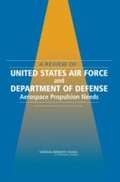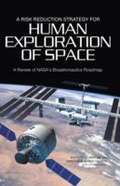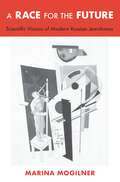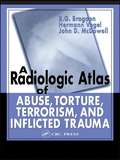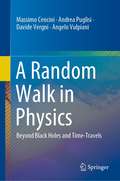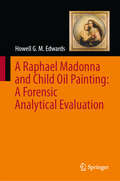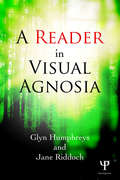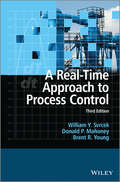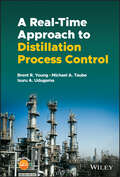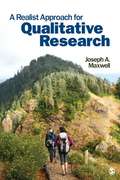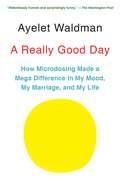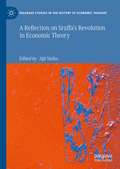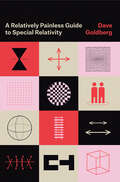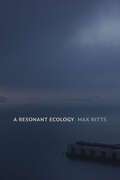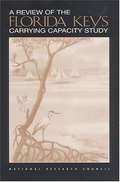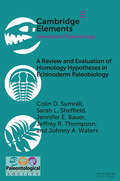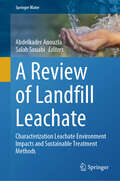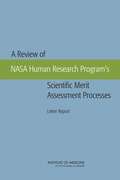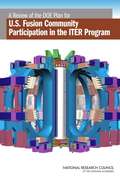- Table View
- List View
A REVIEW OF UNITED STATES AIR FORCE and DEPARTMENT OF DEFENSE Aerospace Propulsion Needs
by National Research Council of the National AcademiesThe National Academies Press (NAP)--publisher for the National Academies--publishes more than 200 books a year offering the most authoritative views, definitive information, and groundbreaking recommendations on a wide range of topics in science, engineering, and health. Our books are unique in that they are authored by the nation's leading experts in every scientific field.
A RISK REDUCTION STRATEGY FOR HUMAN EXPLORATION OF SPACE: A Review of NASA's Bioastronautics Roadmap
by Institute of Medicine National Research Council of the National AcademiesThe National Academies Press (NAP)--publisher for the National Academies--publishes more than 200 books a year offering the most authoritative views, definitive information, and groundbreaking recommendations on a wide range of topics in science, engineering, and health. Our books are unique in that they are authored by the nation's leading experts in every scientific field.
A Race for the Future: Scientific Visions of Modern Russian Jewishness
by Marina MogilnerThe forgotten story of a surprising anti-imperial, nationalist project at the turn of the twentieth century: a grassroots movement of Russian Jews to racialize themselves.In the rapidly nationalizing Russian Empire of the late nineteenth century, Russian Jews grew increasingly concerned about their future. Jews spoke different languages and practiced different traditions. They had complex identities and no territorial homeland. Their inability to easily conform to new standards of nationality meant a future of inevitable assimilation or second-class minority citizenship. The solution proposed by Russian Jewish intellectuals was to ground Jewish nationhood in a structure deeper than culture or territory—biology.Marina Mogilner examines three leading Russian Jewish race scientists— Samuel Weissenberg, Alexander El’kind, and Lev Shternberg—and the movement they inspired. Through networks of race scientists and political activists, Jewish medical societies, and imperial organizations like the Society for the Protection of the Health of the Jewish Population, they aimed to produce “authentic” knowledge about the Jewish body, which would motivate an empowering sense of racially grounded identity and guide national biopolitics. Activists vigorously debated eugenic and medical practices, Jews’ status as Semites, Europeans, and moderns, and whether the Jews of the Caucasus and Central Asia were inferior. The national science, and the biopolitics it generated, became a form of anticolonial resistance, and survived into the early Soviet period, influencing population policies in the new state.Comprehensive and meticulously researched, A Race for the Future reminds us of the need to historically contextualize racial ideology and politics and makes clear that we cannot fully grasp the biopolitics of the twentieth century without accounting for the imperial breakdown in which those politics thrived.
A Radiologic Atlas of Abuse, Torture, Terrorism, and Inflicted Trauma
by B. G. Brogdon Hermann Vogel John D. McDowellThe results of aggression against humans can be hideously obvious, but may also be entirely concealed from casual inspection. Often, only exploration of the hidden recesses of the mind via psychiatric evaluation, or radiologic exploration of the inner recesses of the body can reveal the evidence of such violence. This book focuses on the latter.<BR
A Random Walk in Physics: Beyond Black Holes and Time-Travels
by Angelo Vulpiani Andrea Puglisi Massimo Cencini Davide VergniThis book offers an informal, easy-to-understand account of topics in modern physics and mathematics. The focus is, in particular, on statistical mechanics, soft matter, probability, chaos, complexity, and models, as well as their interplay. The book features 28 key entries and it is carefully structured so as to allow readers to pursue different paths that reflect their interests and priorities, thereby avoiding an excessively systematic presentation that might stifle interest. While the majority of the entries concern specific topics and arguments, some relate to important protagonists of science, highlighting and explaining their contributions. Advanced mathematics is avoided, and formulas are introduced in only a few cases. The book is a user-friendly tool that nevertheless avoids scientific compromise. It is of interest to all who seek a better grasp of the world that surrounds us and of the ideas that have changed our perceptions.
A Raphael Madonna and Child Oil Painting: A Forensic Analytical Evaluation
by Howell G. EdwardsThis book presents a comprehensive forensic analysis of an oil painting depicting a Madonna and Child in a tondo format, previously thought to be a Victorian copy. Detailed historical and scientific studies confirm that this painting was, in fact, created by Raphael around 1512 as a study for his renowned Sistine Madonna, commissioned by Pope Julius II as an altarpiece for the monastic church of San Sisto in Piacenza. The painting underwent rigorous forensic examination, combining historical research with both invasive and non-invasive scientific imaging techniques. The analysis utilized advanced physical and chemical instrumentation to determine the painting's authenticity and accurate chronological placement. A comparative review of published chemical analyses of pigments, dyes, and substrates used in Raphael’s works from collections worldwide is included. Additionally, this study explores the innovative use of artificial intelligence (AI) for facial comparison between the figures in the tondo painting, the Sistine Madonna, and other Raphael artworks. These AI-generated insights provide novel information about the identities of Raphael’s models and shed light on his working techniques, as well as those of his associates.
A Rat's Tale
by Ann McLainRats are opportunistic, living in human cities provides them with food, shelter, and everything else they need!
A Reader in Visual Agnosia: To See But Not To See
by Jane Riddoch Glyn HumphreysThe case study of John has provided a unique insight into the nature of visual agnosia and more broadly into the underlying processes which support human vision. After suffering a stroke, John had problems in recognizing common objects, faces, seeing colours, reading and finding his way around his environment. A Reader in Visual Agnosia brings together the primary scientific papers describing the detailed investigations for each visual problem which the authors carried out with John, known as patient HJA. This work was summarised initially in To See But Not To See (1987), and 26 years later in A Case Study in Visual Agnosia Revisited (2013). The chapters are divided into 6 parts corresponding to the key areas of investigation: Integrative visual agnosia Perception of global form Face perception Colour perception Word recognition Changes over time Each part contains a short introduction, written by the two leading researchers who worked with John, which highlights the relations between the papers and demonstrates the pathway of the case analysis. The book will be invaluable to students and researchers in visual cognition, cognitive neuropsychology and vision neuroscience.
A Real-Time Approach to Process Control
by Donald P. Mahoney William Y. Svrcek Brent R. YoungWith resources at a premium, and ecological concerns paramount, the need for clean, efficient and low-cost processes is one of the most critical challenges facing chemical engineers. The ability to control these processes, optimizing one, two or several variables has the potential to make more substantial savings in time, money and resources than any other single factor. Building on the success of the previous editions, this new third edition of A Real-Time Approach to Process Control employs both real industry practice and process control education without the use of complex or highly mathematical techniques, providing a more practical and applied approach.Updated throughout, this edition:* Includes a brand new chapter on Model predictive Control (MPC)* Now includes wireless and web-based technologies* Covers bio-related systems* Details the new multivariable control measure developed by the authors* Includes PowerPoint slides and solutions to Workshop problems on the accompanying website: http://www.wiley.com/go/svrcek-real-time-3e From the reviews of previous editions:"Would appeal to practising engineers due to its "hands on" feel for the subject matter. But more importantly, the authors present these concepts as fundamentals of chemical engineering, in a way that is consistent with how professor teach at the universities." -Chemical Engineering Process (CEP)"The book has been beautifully crafted" -Engineering Subject Centre"Provides a refreshing approach to the presentation of process analysis and control" -The Chemical Engineer
A Real-time Approach to Distillation Process Control
by Brent R. Young Michael A. Taube Isuru A. UdugamaA Real-Time Approach to Distillation Process Control A practical and hands-on discussion of modern distillation control In A Real-time Approach to Distillation Process Control, a team of distinguished researchers and industrial practitioners delivers a practical text combining hands-on and active learning using process simulation with discussions of the fundamental knowledge and tools required to apply modern distillation control principles. The book offers a balanced, real-time approach integrated with practical insights. It includes many exercises designed to be simulator agnostic that can be performed on the process simulator locally available to the reader. Readers will discover explorations of topics including distillation control hardware, distillation composition control, refinery versus chemical plant distillation control, distillation control tuning, advanced regulatory control, and more. They’ll also find: A thorough introduction to distillation fundamentals, as well as basic and advanced modern controls from a practical point of view Comprehensive explorations of known base controls combined with modern control practices Practical discussions of hands-on modelling and simulation exercises, allowing the reader to design and tune controls on a distillation column Fulsome treatments of control structure design integrated with controller tuning using a real-time approach Perfect for senior undergraduate and graduate students studying general process control or distillation process control, A Real-time Approach to Distillation Process Control will also benefit plant managers, production supervisors, startup supervisors, operations engineers, production engineers, and chemical engineers working in industry.
A Realist Approach For Qualitative Research
by Joseph A. MaxwellThis ground-breaking book makes the case for adopting a realist philosophical perspective for qualitative research. Joseph Maxwell argues for critically applying a realist ontology to a number of important theoretical and methodological issues. This can provide a stronger justification for what qualitative researchers do, he contends, and significantly contribute to current theories and practices. The book outlines critical realism and considers its implications for how we conceptualize meaning and culture, causation, and diversity. The author applies critical realist ideas and approaches to the design and methods of qualitative research, and presents two in-depth case studies of projects he conducted, describing how realist (and other) perspectives informed the research, the methods, and the conclusions.
A Realist Theory of Science (Radical Thinkers)
by Roy Bhaskar<i>A Realist Theory of Science</i> is one of the few books that have changed our understanding of the philosophy of science. In this analysis of the natural sciences, with a particular focus on the experimental process itself, Roy Bhaskar provides a definitive critique of the traditional, positivist conception of science and stakes out an alternative, realist position. Since it original publication in 1975, a movement known as ‘Critical Realism’, which is both intellectually diverse and international in scope, has developed on the basis of key concepts outlined in the text. The book has been hailed in many quarters as a ‘Copernican Revolution’ in the study of the nature of science, and the implications of its account have been far-reaching for many fields of the humanities and social sciences.
A Really Good Day: How Microdosing Made a Mega Difference in My Mood, My Marriage and My Life
by Ayelet Waldman'Ayelet Waldman is fearless' - Rebecca Solnit'Genuinely brave and human' - The New York Times'Wildly brilliant' - ElleThe true story of how a renowned writer's struggle with mood storms led her to try a remedy as drastic as it is forbidden: microdoses of LSD. Her fascinating journey provides a window into one family and the complex world of a once-infamous drug seen through new eyes.When a small vial arrives in her mailbox from 'Lewis Carroll,' Ayelet Waldman is at a low point. Her mood storms have become intolerably severe; she has tried nearly every medication possible; her husband and children are suffering with her. So she opens the vial, places two drops on her tongue, and joins the ranks of an underground but increasingly vocal group of scientists and civilians successfully using therapeutic microdoses of LSD. As Waldman charts her experience over the course of a month - bursts of productivity, sleepless nights, a newfound sense of equanimity - she also explores the history and mythology of LSD, the cutting-edge research into the drug, and the byzantine policies that control it. Drawing on her experience as a federal public defender, and as the mother of teenagers, and her research into the therapeutic value of psychedelics, Waldman has produced a book that is eye-opening, often hilarious, and utterly enthralling.
A Really Good Day: How Microdosing Made a Mega Difference in My Mood, My Marriage, and My Life
by Ayelet Waldman<P>A revealing, courageous, fascinating, and funny account of the author's experiment with microdoses of LSD in an effort to treat a debilitating mood disorder, of her quest to understand a misunderstood drug, and of her search for a really good day. <P>When a small vial arrives in her mailbox from "Lewis Carroll," Ayelet Waldman is at a low point. <P>Her mood storms have become intolerably severe; she has tried nearly every medication possible; her husband and children are suffering with her. <P>So she opens the vial, places two drops on her tongue, and joins the ranks of an underground but increasingly vocal group of scientists and civilians successfully using therapeutic microdoses of LSD. <P>As Waldman charts her experience over the course of a month--bursts of productivity, sleepless nights, a newfound sense of equanimity--she also explores the history and mythology of LSD, the cutting-edge research into the drug, and the byzantine policies that control it. <P>Drawing on her experience as a federal public defender, and as the mother of teenagers, and her research into the therapeutic value of psychedelics, Waldman has produced a book that is eye-opening, often hilarious, and utterly enthralling.
A Reflection on Sraffa’s Revolution in Economic Theory (Palgrave Studies in the History of Economic Thought)
by Ajit SinhaThis book presents a substantial collection of essays from a wide range of well respected scholars addressing several aspects of Piero Sraffa’s economics in light of continuing controversies over the interpretation that should be placed on his work. It moves beyond extant scholarship with an added emphasis on the philosophical dimension of Sraffa’s seminal work, Production of Commodities by Means of Commodities. Contributors probe new ways of thinking about the political economy of Sraffa and in doing so, alongside the comments to each contribution by other scholars, provide a cutting edge debate and discussion on non-mainstream economic theory.This book will be of interest to academics and advanced graduate students in economics, with additional interest from scholars in philosophy and the methodology of science.
A Relatively Painless Guide to Special Relativity
by Dave GoldbergSerious and accessible—finally the special relativity course book that both physics majors and lifelong learners deserve. Special relativity challenges one’s physical intuition of space, time, matter, and energy in a way that few other topics in physics do. Yet the subject is often treated as an extra in undergraduate courses—something to be picked up in a few random lectures and presented as a combination of geometric and logical puzzles (seemingly with the premise of getting the novice student to concede that Einstein was a genius and that the universe is weird). But special relativity is absolutely fundamental to modern physics. It is the canvas on which electromagnetism, particle physics, field theory, and ultimately general relativity are based. For physics students, developing a relativistic intuition isn’t just a luxury: it’s a requirement. Physicist and popular author Dave Goldberg provides a rigorous but conversational introduction to fill this void in spacetime education. Employing the standard calculus a sophomore or junior university student in science, engineering, or computer science will have encountered, Goldberg connects relativity to a student’s work ahead, acquainting them with topics like tensors, the development of new physical theories, and how relativity directly relates to other disciplines. But more than this, Goldberg welcomes lifelong learners who may have encountered special relativity in popular accounts, but are seeking a mathematical challenge to understand an elegant physical theory.
A Reminder for Emily: An Electrical Engineering Story
by Engineering is Elementary TeamA story for elementary school students to discover that electrical engineering can be for everyone.
A Resilience Approach to Acceleration of Sustainable Development Goals
by Mika ShimizuThis is the first book to articulate how to address interlinkages among sustainable development goals (SDGs), which are keys to implementing those goals by 2030. At the heart of the book is a resilience approach to the enabling relevant systems, practices, and education and research. While SDGs are well known at different levels from local to global spheres, a major gap can be seen between goals and approaches, as approaches are lacking for addressing interlinkages among SDGs. The United Nations General Assembly in 2015 acknowledged interlinkages as being of crucial importance in ensuring the purpose of the goals. However, few actual approaches have been specified to address the interlinkages or interconnections at both the policy and practical levels. Thus, it is urgent to face the question of how to address the interlinkages by stakeholders—not only policy communities and researchers but also practitioners and students, especially innovators who can go beyond existing boundaries. By highlighting that challenge, this book lays out a path for addressing interlinkages among SDGs by applying a resilience approach to the issues of a sustainable society. The resilience approach has been developed from combinations of different modes of thinking and practices, including the systems approach, systems and design thinking, and resilience thinking and practices. Based on this overarching approach, innovators seek out the relevance of that approach to their SDGs-related practices at the system, local, and educational levels. The book therefore serves as a guide to how the resilience approach can contribute to accelerating implementation of SDGs by 2030.
A Resonant Ecology (Sign, Storage, Transmission)
by Max RittsIn A Resonant Ecology, Max Ritts traces how sound’s integration into the environmental politics of Canada’s North Coast has paved the way for massive industrial expansion. While conservationists hope that the dissemination of whale songs and other nature sounds will showcase the beauty of local wildlife for people around the world, Ritts reveals how colonial capitalism can co-opt sonic efforts to protect the coast. He demonstrates how digital technologies allow industry to sonically map new shipping lanes and facilitate new ways of experiencing sound—premised not on listening, but on sound’s exploitable status as a data resource. By outlining how sound can both perpetuate and refuse capitalist colonialism, Ritts challenges the idea that the sonic realm is inherently liberatory and reveals sound to be a powerfully uncertain object. Through a situated geographical approach, he makes the case that only a decolonial and multigenerational environmental politics can counter the false promise of “sustainable marine development” held up by industry and the state.
A Review Of The Florida Keys Carrying Capacity Study
by Committee to Review the Florida Keys Carrying Capacity StudyA Review Of The Florida Keys Carrying Capacity Study
A Review and Evaluation of Homology Hypotheses in Echinoderm Paleobiology (Elements of Paleontology)
by Jennifer E. Bauer Jeffrey R. Thompson Sarah L. Sheffield Colin D. Sumrall Johnny A. WatersThe extraxial-axial theory (EAT) and universal elemental homology (UEH) are often portrayed as mutually exclusive hypotheses of homology within pentaradiate Echinodermata. EAT describes homology upon the echinoderm bauplan, interpreted through early post-metamorphic growth and growth zones, dividing it into axial regions generally associated with elements of the ambulacral system and extraxial regions that are not. UEH describes the detailed construction of the axial skeleton, dividing it into homologous plates and plate series based on symmetry, early growth, and function. These hypotheses are not in conflict; the latter is rooted in refinement of the former. Some interpretive differences arise because many of the morphologies described from eleutherozoan development are difficult to reconcile with Paleozoic forms. Conversely, many elements described for Paleozoic taxa by UEH, such as the peristomial border plates, are absent in eleutherozoans. This Element recommends these two hypotheses be used together to generate a better understanding of homology across Echinodermata.
A Review of Landfill Leachate: Characterization Leachate Environment Impacts and Sustainable Treatment Methods (Springer Water)
by Salah Souabi Abdelkader AnouzlaSolid waste landfilling and related environmental issues have become global concerns, particularly in developing countries. Accelerating population growth and changing lifestyles have exacerbated health and environmental challenges. This book looks at the global ramifications of leachate characterization and environmental impacts, highlighting the different issues related to landfilling, such as leachate generation and its constituents. When water enters a landfill, it assimilates the dissolved components of the decomposing waste, thus forming a leachate with considerable impacts on the environment. The nature of the landfill and the waste received (household waste alone or mixed with industrial waste) determine whether the leachate produced is hazardous or not. The decomposition of solid waste in landfills goes through several stages, including an initial aerobic phase, an anaerobic acid phase, an initial methanogenic phase and a stable methanogenic phase. Leachates can contain significant concentrations of heavy metals, inorganic salts, ammonia, halogenated hydrocarbons, suspended matter, organic pollutants in significant quantities... Generally, leachate discharges are rich in phenol, highly toxic polluting ammonium. Ecotoxicological assessment of this effluent is essential to determine the impact of its contaminants on the aquatic ecosystem. If pollutants are not disposed of properly, leachate from landfills can potentially enter soils and subsoils, severely contaminating surface and groundwater bodies. Therefore, reducing pollutant levels through leachate treatment has garnered considerable attention in recent decades. This publication is an invaluable resource, providing up-to-date information on the impact and characterization of leachate landfills. It is therefore time to accentuate the training of executives with all the skills to facilitate the waste management through the research efforts of academics, in the field of solid wastelandfill operations.
A Review of NASA Human Research Program's Scientific Merit Processes
by Institute of Medicine Catharyn T. Liverman Andrea M. Schultz Board on Health Sciences Policy Larisa M. Strawbridge James A. Pawelczyk Committee on the Review of NASA Human Research Program's Scientific Merit Assessment ProcessesAt the request of NASA, an IOM committee reviewed NASA Human Research Program's (HRP's) Scientific Merit Assessment Processes for directed research. Directed research is commissioned or noncompetitively awarded research that is not competitively solicited because of specific reasons, such as time limitations or highly focused or constrained research topics. The scientific merit assessment processes have been developed by NASA to evaluate individual directed research tasks in order to ensure the scientific integrity of the HRP's directed research portfolio. The committee examined the HRP's current scientific merit assessment processes and conducted a public workshop to identify best practices among other federal agencies that use various assessment processes for similar types of directed research. Review of NASA Human Research Program's Scientific Merit Processes: Letter Report finds that the scientific merit assessment process used by the HRP for directed research is scientifically rigorous and is similar to the processes and merit criteria used by many other federal agencies and organizations - including the Department of Defense, National Institutes of Health, and the United States Department of Agriculture - for comparable types of research. This report also makes recommendations on ways to streamline and bolster the accountability and transparency of NASA's current processes.
A Review of the DOE Plan for U.S. Fusion Community Participation in the ITER Program
by National Research Council of the National AcademiesITER presents the United States and its international partners with the opportunity to explore new and exciting frontiers of plasma science while bringing the promise of fusion energy closer to reality. The ITER project has garnered the commitment and will draw on the scientific potential of seven international partners, China, the European Union, India, Japan, the Republic of Korea, Russia, and the United States, countries that represent more than half of the world's population. The success of ITER will depend on each partner's ability to fully engage itself in the scientific and technological challenges posed by advancing our understanding of fusion. In this book, the National Research Council assesses the current U.S. Department of Energy (DOE) plan for U.S. fusion community participation in ITER, evaluates the plan's elements, and recommends appropriate goals, procedures, and metrics for consideration in the future development of the plan.
A Review of the New Initiatives at the NASA Ames Research Center: Summary of a Workshop
by National Research Council Technology Board On Science Economic PolicyNASA Ames Research Center, in the heart of Silicon Valley, is embarking on a program to develop a science and technology park bringing together leading companies and universities to capitalize on Ames’ exceptional mission and location. Other initiatives under consideration include the integration of SBIR grants with a planned on-site incubator, virtual collaboration, and possibly a new public venture capital program. The STEP Board was asked by the NASA Administrator to hold a one-day symposium to review these initiatives. This report includes commissioned research papers and a summary of the proceedings of the symposium organized in response to the NASA request.
